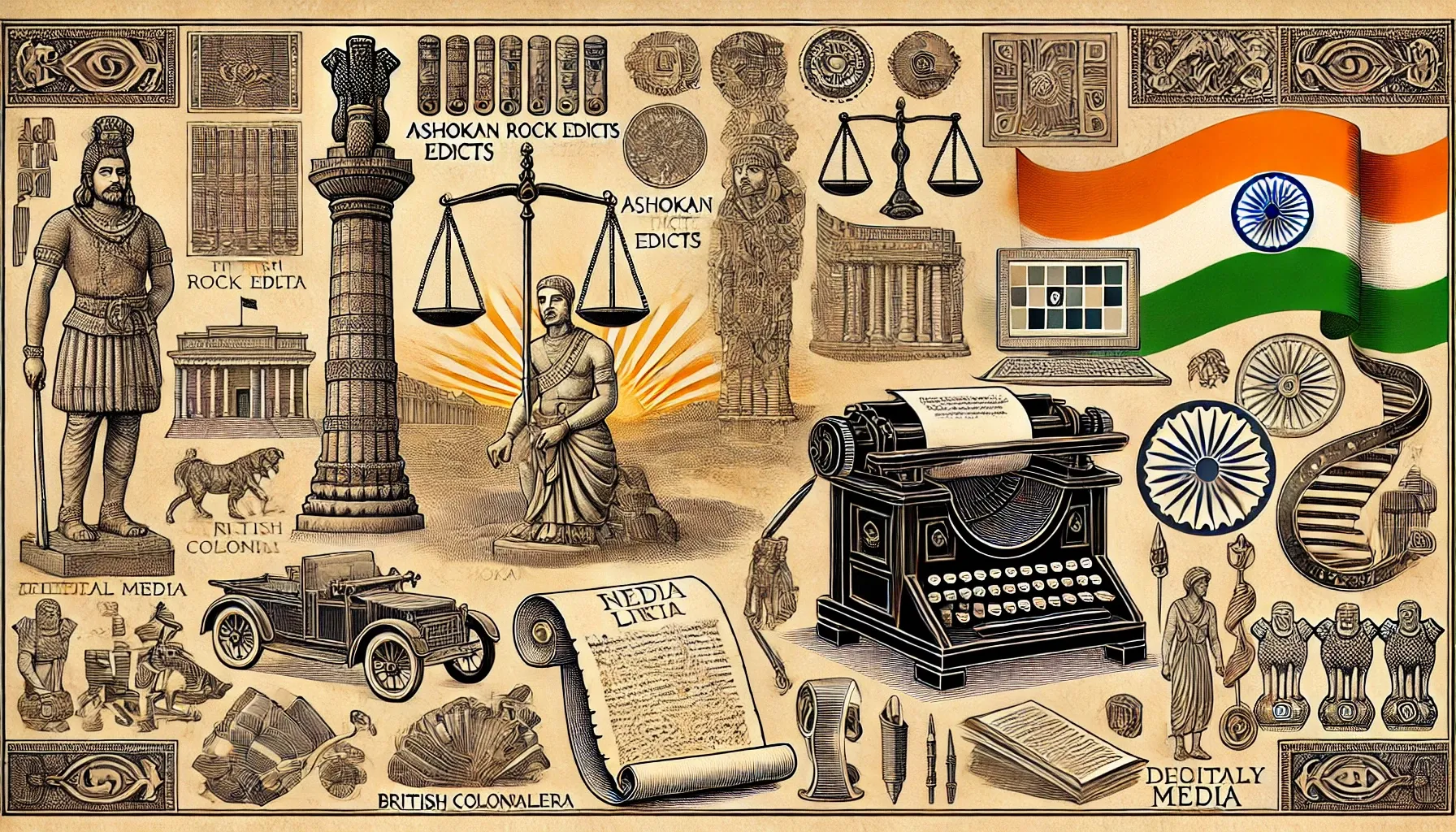Media law in India governs the regulation of media activities, balancing freedom of expression with necessary restrictions. Its evolution spans from ancient India to the colonial era, culminating in post-independence legislation ensuring responsible media practices.

Introduction
Communication serves as a fundamental means of exchanging thoughts and information, with media acting as the primary channel for storing and transmitting this information. The term "media" derived from the Latin word medius, meaning middle, symbolizing its role as a bridge for publicizing news, music, movies, education, promotional content, and more. Modern media encompasses a wide array of platforms, including physical and online newspapers, magazines, e-books, television programs, radio broadcasts, billboards, telephones, the Internet, and fax systems.
As Walter Cronkite aptly stated, "Freedom of the Press is not just important to democracy, it is democracy." While media holds immense potential to foster informed dialogue and promote democratic values, it can also, when misused, propagate false information and divisive messages, perpetuating stereotypes and fostering discord. This dual-edged nature underscores the need for vigilance in regulating its use.
With technological advancements and the rapid growth of the media and entertainment industry, safeguarding media from misuse has become increasingly vital. Recognizing this, the Indian government has introduced laws to regulate media activities while upholding its freedom. Institutions such as the Press Council of India, the Ministry of Information and Broadcasting, the Central Board of Film Certification, and the Telecom Regulatory Authority of India have played pivotal roles by enacting and enforcing regulations to ensure the responsible functioning of the media industry.
What is Media law?
- Media law is a branch of law that consists of a system of legal norms that regulate the activities of the mass media. It examines the limits within which media outlets and journalists can operate.
- Media law regulates the principles of the dissemination of media products, and, on the other hand, it can affect the format and content of media products. Some regulations apply only to specific types of media. For example, there are broadcasting laws that apply only to the activities of broadcast media. More general legal provisions are to be respected by all media
- The law relating to mass media does not constitute a single field of law but rather consists of a diverse set of laws and provisions that are scattered across the entire legal framework.
- The foundations of the principles of media law can be found in the constitutions of many countries, specific national legislation, as well as international conventions and acts dealing with this subject.
History and Evolution of Media Laws in India
The evolution of media laws in India is deeply rooted in the historical, cultural, and political developments of the nation.
Ancient Period
- Ashokan Rock Edicts: The journey begins as early as the reign of Ashoka, where Rock Edicts, engraved on rocks and pillars, served as a medium to disseminate measures and regulations. These edicts, considered equivalent to the modern-day news content, marked the earliest organized communication in the subcontinent.
- Arthashastra: Although there were no explicit restrictions on communication during Ashoka’s time, Arthashastra, authored during the Mauryan era under Chandragupta Maurya, outlined punishments for spreading false rumors and discussed the roles of reporters, reflecting an early attempt to regulate information dissemination.[1]
Mughal Era
- Official Notifications (e.g., Akbar's Decrees): During the Mughal era, official notifications like Akbar’s were used to communicate royal orders, such as tax exemptions. However, there were no specific rules or regulations governing these communications.
- Early References to News Content: The absence of censorship or licensing during this period contrasted with the systems later introduced under European influence. The earliest pre-typographic newspaper references in India appear in the writings of the later Mughals, but no institutional framework for media regulation existed.
British Colonial Era
- Introduction of Press Regulations: With the advent of British rule, significant changes occurred. The Battle of Plassey marked the beginning of British administrative control in India, leading to the introduction of press regulations. Early European publishers in India faced penalties such as expulsion by the Supreme Court of Judicature for offensive content. Concepts of censorship and licensing, rooted in European traditions, were first introduced in Bengal through Adam’s Regulations. Employees of the East India Company were expressly prohibited from associating with newspapers to avoid conflicts of interest.
- Key Acts and Legislation:
a. Metcalfe Act (1835): The Metcalfe Act of 1835 repealed stringent licensing regulations and required publishers to register their premises, reflecting an early attempt at standardizing press activity.
b. Licensing (1857): However, the reintroduction of licensing in 1857 by Lord Canning marked a shift toward tighter control over the press, especially during the political turmoil following the revolt of 1857.
c. Indian Penal Code (1860): The Indian Penal Code of 1860 included provisions to regulate defamation and obscenity in publications, followed by the landmark Press and Registration of Books Act of 1867, which aimed to regulate the printing press and periodicals. The introduction of sedition laws further tightened control, punishing any attempt to incite disaffection against the government.
- Regulation of Cultural Media: Cultural mediums such as drama also came under scrutiny.
a. Dramatic Performance Act (1876): The Dramatic Performance Act of 1876 was enacted to curb performances perceived as seditious, reflecting British apprehension about growing dissent among Indians.
b. Vernacular Press Act (1878): Similarly, the Vernacular Press Act of 1878 sought to regulate publications in Indian languages, ensuring tighter control over regional narratives.
- Telecommunication Control:
a. Indian Telegraph Act (1885): The Indian Telegraph Act of 1885 granted the government exclusive privileges over telecommunication, enabling them to intercept messages across various channels, reflecting a growing effort to control communication networks.
- Additional Restrictive Measures:
a. As the 19th century progressed, the British government introduced more restrictive laws in response to increasing nationalist sentiments. Acts like the Newspaper (Incitement to Offences) Act of 1908, the Press Act of 1910, and the Cinematograph Act of 1918 were designed to suppress revolutionary ideas and hinder communication among freedom fighters. The Press Law Act of 1922 further tightened restrictions on free speech, reflecting the British colonial administration’s efforts to maintain control over the media.
Thus, the history of media laws in India is a reflection of its socio-political evolution, shaped significantly by colonial policies aimed at maintaining authority. Despite these restrictive beginnings, the framework laid during this period influenced the development of post-independence media laws, balancing freedom of expression with regulation.
Media Laws in India
1. Historical Context and Legislative Evolution
A. British Era Regulations: From the very inception, there has been a comprehensive framework of laws governing the media. During the British era, various legislations were introduced to ensure smooth media operations and effective control. Key regulations from this period include:
- First Press Regulation (1799): Early regulation to control media operations.
- Gagging Act (1857): Implemented to suppress dissenting views.
- Vernacular Press Act (1878): Targeted publications in regional languages to control nationalist sentiments.
- Indian Press Act (1910): Further restricted press freedom to curb revolutionary ideas.
- Official Secrets Act (1923): Regulated the dissemination of sensitive government information.
- Press and Registration of Books Act (1867): Required publication registration and oversight.
- Cinematography Act (1952): Regulated film content and screenings.
B. Post-Independence Legislation: Post-independence, further legislative measures such as:
- Press Council of India Act (1965): Established to uphold the freedom and standards of the press.
- Prasar Bharati Act (1990): Created a public broadcasting service to ensure public service broadcasting.
- Cable Television Regulation Act (1995): Regulated cable TV broadcasting and operations.
- Sports Broadcasting Signal Act (2007): Regulated the broadcasting of sports events and rights.
2. Constitutional Provisions
The media plays a crucial role in the democratic system, alongside the legislative, executive, and judiciary branches. While the legislature formulates laws, the executive enforces them, and the judiciary ensures their legitimacy, the media operates within the constitutional and statutory framework in the public and national interest. Although the Indian Constitution does not explicitly provide for media-specific provisions, freedom of the press is inferred from Article 19(1)(a)[2], which guarantees freedom of speech and expression. This right, however, is subject to reasonable restrictions for safeguarding sovereignty, integrity, and other critical interests of the state.
A. Penal Provisions in the Indian Penal Code (IPC): In terms of penal provisions, the Indian Penal Code (IPC) contains sections relevant to media regulation.
- Section 295A[3] addresses deliberate acts to outrage religious feelings
- Section 124A[4] pertains to sedition
- Section 153A[5] prohibits promoting enmity between groups
- Section 505[6] deals with public mischief through false information
- Section 499[7] governs defamation
- Section 509[8] safeguards the modesty of women.
B. Intellectual Property Rights (IPR):
- The domain of Intellectual Property Rights (IPR) is also significant in media regulation. The Copyright Act of 1957, along with its rules and amendments, protects original literary, artistic, and cinematic works while ensuring licensing and broadcasting rights under Sections 13, 22, 30, and 37[9].
- Section 13 of the Copyright Act offers distinct and exclusive protection for various types of works, including original literary, dramatic, musical, and artistic works, as well as cinematographic films and sound recordings.
- Section 22 establishes the terms for the protection of copyright, covering published literary, dramatic, musical, and artistic works.
- Meanwhile, Section 30 addresses the licensing rights that a copyright owner can grant for the use of their content.
- Section 37 focuses on the reproduction rights for broadcasting, further solidifying the legal protections for content creators.
- Together, these sections, along with other provisions under intellectual property rights (IPR), ensure comprehensive safeguarding of copyright owners' interests in their creative works, securing content creators' rights and addressing licensing challenges in the evolving media environment.
C. Regulatory Authorities and Their Functions: Various regulatory authorities oversee the media industry.
- The Ministry of Information and Broadcasting supervises sectors like broadcasting, information dissemination, and films, using specialized units to address diverse communication needs.
- The Press Information Bureau (PIB) acts as the government's communication interface with the media.
- The Registrar of Newspapers monitors publication activities under the Press and Books Registration Act, 1867.
- The Directorate of Advertising and Visual Publicity (DAVP) handles government communication campaigns using diverse media channels.
- The Press Council of India, established in 1966, upholds press freedom and standards.
- The Advertising Standards Council of India promotes self-regulation in advertising.
- The Copyright Board addresses disputes and issues related to copyright registration and licensing.
- The Telecom Regulatory Authority of India (TRAI) oversees telecommunications, ensuring compliance with service standards and managing spectrum usage.
- The Directorate of Field Publicity facilitates rural interpersonal communication.
- The Central Board of Film Certification regulates public film exhibitions under the Cinematograph Act, 1952.
Conclusion
The media stands as a fourth pillar of democracy, with its power to shape public opinion, expose injustices, and disseminate knowledge. Its role extends beyond traditional boundaries, encompassing the ever-expanding realm of digital and online platforms. While press freedom is integral to a democratic society like India, ensuring accountability and ethical conduct is equally essential to maintain societal harmony and protect individual rights.
The evolution of media laws reflects a delicate balance between safeguarding freedom of speech and expression and imposing necessary restrictions to prevent misuse. The current legal framework, although comprehensive, must adapt to the challenges posed by modern media dynamics, particularly in regulating sensitive matters such as trial coverage and the potential impact on justice delivery.
Ultimately, responsible media practices, supported by well-regulated legal provisions, are indispensable for upholding democratic values, fostering informed citizenry, and promoting the collective well-being of society.
[1] CA Rajkumar S. Adukia, Media Laws of India.
[2] The Indian Constitution, art. 19(1)(a).
[3] The Indian Penal Code, s. 295A.
[4] Id. at s. 124A.
[5] Id. at s. 153A.
[6] Id. at s. 505.
[7] Id. at s. 499.
[8] Id. at s. 509.
[9] The Copyright Act, 1957, ss. 13, 22, 30. 37.


